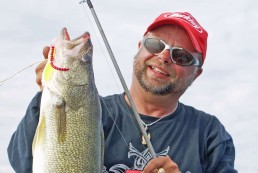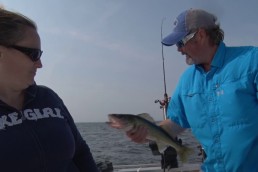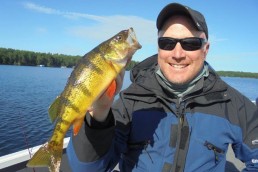Stop Mindlessly Towing and Start Really Trolling
SHARE THIS POST
Overall, the tactic that anglers employ the most is trolling. It’s the technique used by more professional tournament angers, charter captains, guides and weekend warriors, no matter the species. It’s the simple strategy of pulling both lures and live bait behind a boat that anyone can use.
Just because most anglers troll doesn’t mean that everyone is going to catch fish. There’s more to trolling than just the forward motion of a boat with offerings in tow. Paying attention to the most minor details, such as boat control and knowing the exact location of baits in the water column, is crucial, but so is fishing where the fish swim.
Lure me this, bait me that
One of the first questions anglers attending my fishing seminars ask me involves lures and rigs I use most often. It’s not just about a brand; it’s about shape, dive curve and action.
More often than not, the first lure I tie on is one of the many styles of Rapala crankbaits because these allow me to cover more water quickly so I can find active fish faster. I always use a Berkley Snap (not snap-swivel) when using crankbaits. The open ring allows the lure to keep its full erratic action without any added weight to the nose.
Whether I decide to use a shallow-running crankbait that swims to a medium depth or a deep diver that plummets into the darkened depths will depend on where I am marking the fish on my sonar.
No matter the targeted species, I always want my lures to be swimming at the same exact depth or just above the fish, and never below. This is because they rarely rush downward to attack prey; instead, they scuttle skyward to sabotage forage.
After I figure out where in the water column the fish are and which lures to choose based on their dive curve, it’s time to narrow the number down even more and pick out ones via their shape from my Plano tackle totes. In general, I’ll grab a long, slender-shaped Rapala like a Scatter Rap or a Down Deep Husky Jerk for waterways where forage like shiner minnows, herring or other narrow-shaped baitfish swim. If shad, bluegills and crappies are the main food source, wide-bodied cranks like Shad Raps or Scatter Rap Shads will be tried first.
For colors in stained waters, I’ll run lures that are bright or have a UV paint job. For lakes or rivers with clear water, the more natural colors get picked from the pile.
Speed and placement
Once I have my lures picked out and clipped on, it’s time to troll and make sure lures are swimming at the correct speed and are through the strike zone.
With my Lowrance HDS-12 Gen3 Touch in “multiple screen mode,” I can see 2D sonar, StructureScan HD and GPS/mapping/tracking (aided by SD card with Navionics mapping in unit’s card reader) simultaneously. This allows me to know my speed, if there are fish in an area and my location at any time.
Are you enjoying this post?
You can be among the first to get the latest info on where to go, what to use and how to use it!
Right off the bat, I’ll start trolling at 1.9 to 2.4 mph and will hold this rate for at least 20 minutes, all the while watching for fish on the sonar. If I don’t get any strikes, I’ll either slow down or speed up in increments of about .5 mph. If a lure running on the inside of the turn gets bit, then I know I should slow down. If the opposite happens and an outside rod goes off, I speed up.
If I find fish attracted to speeds slower than my crankbaits will properly run, say 1.3 mph or under, I’ll then switch to lures and/or live bait that can handle decreased speeds. When trolling for walleyes, I’ll run a Northland Baitfish Spinner Harness, nipped with lively nightcrawlers fresh from my bait container. And if panfish are pesky and nipping the tail off my caught ‘crawlers, I’ll opt for one from Berkley Gulp.
Ready, Aim, Troll
I now have my boat in position. But are my lures where they belong?
In shallow water, a boat running over top breaklines and structure will more than likely spook fish. This is why I use Church Tackle in-line planer boards to get my baits out away from the boat and in front of fish that are not spooked yet.
Another must is to make sure I have an SD card with Navionics mapping loaded in my Lowrance’s card reader. The detailed lake maps that show up on the screen behind my chart plotter are precise and allow me to troll perfectly along breaklines.
Why do I need to be so particular when it comes to following contours? Because it’s right along these very drop-offs, no matter how major or minor, where fish will swim most often. If my lures are following the contours exactly, they will be in the strike zone and in the faces of more fish.
No trolling? Know trolling
There’s a good reason anglers troll: They are able to get their bait in front of more fish, and fast. It’s a simple strategy of pulling both lures and live bait behind the boat. But it’s the details that mean a lot when catching. Boat control, knowing the exact location of baits and knowing these are running correctly and locating the fish, are crucial. MWO
Mark Martin is a professional walleye tournament angler and instructor with the Ice Fishing School/Vacation series. Check out his website at markmartins.net or fishingvacationschool.com for more information.
Mark Martin holds a nice walleye he landed while trolling a ‘crawler harness high in the water column at a snail’s pace. Photo: Mark Martin
MWO
SHARE THIS POST
Did you enjoy this post?
You can be among the first to get the latest info on where to go, what to use and how to use it!
Mark Martin
Mark Martin is a professional walleye tournament angler and instructor with the Ice Fishing School/Vacation series. For more information, check out his website at markmartins.net or fishingvacationschool.com.



